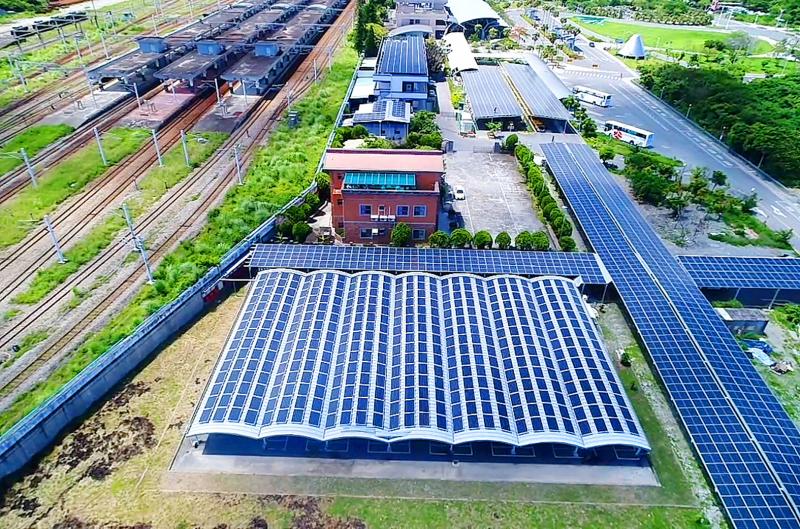Taitung Railway Station has become the nation’s first railway station that can generate additional revenue by producing solar energy, the Taiwan Railways Administration (TRA) said yesterday.
The agency said it had installed solar panels on the roofs of 12 buildings within the parameters of the Taitung Railway Station in accordance with the government’s policy to develop green energy, conserve electricity and reach net zero carbon emissions by 2050.
Taitung has the unique advantage of developing solar energy as it has sufficient and unimpeded sunlight, the TRA said.

Photo provided by the Taiwan Railways Administration
In addition to roofs, solar power panels have been installed on shades over sidewalks, parking lots and taxi stops, it said.
The total area covered by solar panels at the station is 8,652m2, with a power-generating capacity of 1.51 megawatts, it said.
The production of green energy helped reduce carbon emissions by about 820,517kg per year, which is equivalent to the amount of carbon dioxide that can be absorbed by two Daan Forest Parks in Taipei, the TRA said.
It can generate an annual revenue of NT$870,000 per year by selling the green energy to the Taiwan Power Co, it added.
Taxi drivers and passengers accessing the train station benefit from solar panel-covered shades that shield them from rain or sunlight, it said.
The success of the Taitung Railway Station in producing solar energy has motivated the agency to install solar panels in other railway stations around the country, it said.

Taiwan is to commence mass production of the Tien Kung (天弓, “Sky Bow”) III, IV and V missiles by the second quarter of this year if the legislature approves the government’s NT$1.25 trillion (US$39.78 billion) special defense budget, an official said yesterday. Commenting on condition of anonymity, a defense official with knowledge of the matter said that the advanced systems are expected to provide crucial capabilities against ballistic and cruise missiles for the proposed “T-Dome,” an advanced, multi-layered air defense network. The Tien Kung III is an air defense missile with a maximum interception altitude of 35km. The Tien Kung IV and V

The disruption of 941 flights in and out of Taiwan due to China’s large-scale military exercises was no accident, but rather the result of a “quasi-blockade” used to simulate creating the air and sea routes needed for an amphibious landing, a military expert said. The disruptions occurred on Tuesday and lasted about 10 hours as China conducted live-fire drills in the Taiwan Strait. The Civil Aviation Administration (CAA) said the exercises affected 857 international flights and 84 domestic flights, affecting more than 100,000 travelers. Su Tzu-yun (蘇紫雲), a research fellow at the government-sponsored Institute for National Defense and Security Research, said the air

Taiwan lacks effective and cost-efficient armaments to intercept rockets, making the planned “T-Dome” interception system necessary, two experts said on Tuesday. The concerns were raised after China’s military fired two waves of rockets during live-fire drills around Taiwan on Tuesday, part of two-day exercises code-named “Justice Mission 2025.” The first wave involved 17 rockets launched at 9am from Pingtan in China’s Fujian Province, according to Lieutenant General Hsieh Jih-sheng (謝日升) of the Office of the Deputy Chief of the General Staff for Intelligence at the Ministry of National Defense. Those rockets landed 70 nautical miles (129.6km) northeast of Keelung without flying over Taiwan,

A strong continental cold air mass is to bring pollutants to Taiwan from tomorrow, the Ministry of Environment said today, as it issued an “orange” air quality alert for most of the country. All of Taiwan except for Hualien and Taitung counties is to be under an “orange” air quality alert tomorrow, indicating air quality that is unhealthy for sensitive groups. In China, areas from Shandong to Shanghai have been enveloped in haze since Saturday, the ministry said in a news release. Yesterday, hourly concentrations of PM2.5 in these areas ranged from 65 to 160 micrograms per cubic meter (mg/m³), and pollutants were